How to select shale shaker screen mesh size
Selecting the right mesh size for your shale shaker screen is crucial to ensure efficient solids separation during the drilling process. The mesh size directly affects the performance of the shaker and influences the quality of the drilling fluid. Here’s a guide on how to select the right shale shaker screen mesh size based on several key factors:

1. Understand the API Mesh Designation System
The mesh size is often referred to using the API (American Petroleum Institute) mesh designation system. This system classifies shaker screens based on the mesh opening size, usually measured in microns (μm). The API system assigns numbers like API 20, API 40, API 60, etc., where:
Lower API numbers correspond to coarser meshes that allow larger particles to pass through.
Higher API numbers correspond to finer meshes that retain smaller particles, improving the quality of the drilling fluid.
For example:
API 20: Large mesh, used for coarse solids removal.
API 200: Fine mesh, used for removing smaller solids.
2. Determine the Desired Solids Removal Efficiency
The key factor in selecting the right mesh size is the size of the solids you want to remove from the drilling fluid. The mesh size should be chosen based on the particle size distribution of the drilling cuttings and the desired level of fluid recovery.
Coarse Solids Removal: For larger cuttings (e.g., drill shavings, coarse sand), you would need a larger mesh (lower API number, e.g., API 20-40).
Fine Solids Removal: For finer solids (e.g., mud cake, small drilling debris), a smaller mesh (higher API number, e.g., API 200-325) is required.
3. Consider the Drilling Fluid Type
Different types of drilling fluids (water-based mud, oil-based mud, synthetic fluids) may have different viscosities and solid content.
High Viscosity Fluids: If you're using a high viscosity fluid, you may need a finer mesh to prevent the fluid from losing too many solids.
Low Viscosity Fluids: For low viscosity fluids, a coarser mesh may be sufficient to allow for faster flow rates without risking clogging the screen.
4. Flow Rate and G-Force Consideration
Higher G-forces used in shale shakers can lead to more efficient solids separation. If you are operating at high G-forces, you might want a slightly coarser mesh since the shaker will be more effective in removing solids. However, if the G-force is low, you might need finer mesh to help retain more solids.
5. Understand the Trade-Off Between Flow Rate and Solids Removal
There is always a trade-off between achieving a high flow rate and effective solids removal. Coarser screens (lower API numbers) allow more fluid to pass but are less effective at removing fine particles. Finer screens (higher API numbers) will remove smaller particles, but they may restrict the flow rate.
6. Environmental and Well Conditions
Environmental factors and the specific drilling well conditions will also influence the choice of mesh size.
Shallow wells: In these wells, you may encounter larger cuttings, so you might opt for coarser screens.
Deep wells: In deeper wells, the solid content tends to be finer, so finer screens are more effective.
7. Check Manufacturer Guidelines
Always consult with the shaker and screen manufacturers for recommended mesh sizes that are suitable for your equipment. They may also provide guidelines based on the shaker model and specific drilling conditions.
8. Consider the Mesh Type (Woven vs. Composite)
While the mesh size is important, the type of mesh (woven wire, composite, or perforated) also impacts the performance:
Woven Wire Mesh: Traditional mesh that provides great durability, but may be more prone to clogging when handling fine solids.
Composite Mesh: Generally provides better wear resistance and can handle higher fluid flow, but may be less efficient for fine solids separation compared to finer woven wire mesh.
9. Screen Durability and Maintenance
Finer meshes may be more prone to wear and clogging, which can reduce screen life and increase maintenance requirements. For environments with high abrasiveness or where solids are difficult to separate, you may want to consider more durable, longer-lasting screen options that strike a balance between mesh size and durability.
10. Match with the Shale Shaker’s Performance
Ensure that the selected screen mesh size matches the performance characteristics of your shale shaker. If your shaker operates at high G-forces and has a high capacity, a coarser mesh may work best. However, for a shaker with lower G-force and flow capacity, a finer mesh might be more appropriate.







